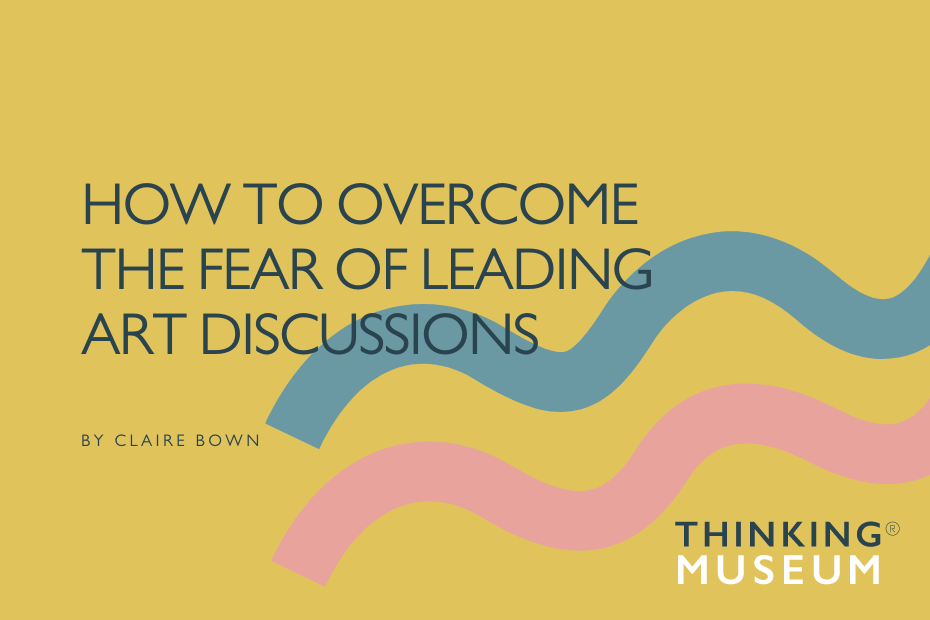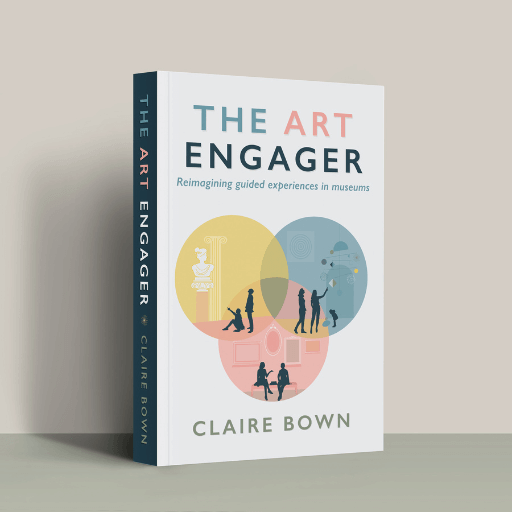Leading tours and educational programmes that are based on discussion, inquiry and interaction can be a scary business. Both for you and for your participants.
And if you’re about to take your first steps, it might seem really daunting. However, do remember that any concerns you have are perfectly normal and you’re not alone (we’ve all been there and had to start somewhere). Take it one step at a time and with time, practice and guidance, it will get easier (I promise!).
In this post, I’ve summarised the most common fears and concerns about leading discussion-based programmes that I’ve heard over the last 20 years, along with suggestions for ways to overcome them.
There’s no script to fall back on
Sometimes a script is provided by an organisation or company to help their educators and guides lead informative sessions. Perhaps your script isn’t even an official one – it’s just your detailed notes for what you want to say about each artwork or object.
BUT.
It’s time to ditch the script.
People want to be able to participate, connect and converse with you and the artwork/object you are discussing. Lectures and traditional-style walk-and-talk tours are outdated. And no-one can concentrate for more than a few minutes when someone is ‘transmitting’ information at them, no matter how good the delivery is.
Maybe you’re worried that your mind will go blank or you won’t know what to say. You’re used to having that ‘security blanket’ of a script to fall back on when you are on tour or leading educational programmes in museums and heritage sites.
If you memorise what you want to say or repeat words from a script, all this does is make your delivery sound impersonal (and in some cases, robotic). There is also nothing worse than being in the same spot, saying the same thing at the same time.
So, it’s time to rethink your role. Think of yourself as a ‘guide-on-the-side’ rather than the ‘sage-on-the-stage’.
It can be difficult to change to a new way of working but stick with it and the rewards are plentiful.
The golden rule with any discussion-based programme is practice, practice, practice. Learn the organisation and order of your session. Prepare responses to anticipated questions. Try to think like that one person who always tries to ask challenging questions to the facilitator (i.e. you!).
Familiarity brings confidence and practice will help you to deliver the session in a natural and flexible way. Yes, you will feel naked without your script the first time you lead a session that is more discussion-based than walk-and-talk, but with practice it will get easier and it will be more rewarding.
Where do I share my knowledge?
There is a common misconception that leading dialogue-based or inquiry-led sessions about art and artefacts prevents you from adequately sharing your knowledge. That your group will somehow miss out from receiving the information you can provide for them.Not true. You can create meaningful discussion-based programmes with and without information. If your programme is one where participants expect you to share appropriate knowledge, think about how and when you share it. Any information should be shared in small amounts throughout the discussion. When you are about to start sharing something, consider the following questions:
Does your expert art historical knowledge guarantee a memorable or rewarding experience for your visitors or could it actually be detracting from their own personal insights?
Does your information provide a jumping-off point for group dialogue or actually shut down new insights from the participants?
Any information you share should be there to further the discussion. Learn how to use the knowledge you have as a tool to create curiosity and engagement. Another way of thinking about it, is to imagine yourself as the orchestrator or facilitator of the discussion. You are helping participants to discover information for themselves. This is not about providing content and facts. Don’t forget that you are the ‘guide-on-the-side’ rather than the ‘sage-on-the-stage’. For more information on how to share your knowledge intentionally, see this post.
Losing control – not knowing where it will go
Maybe one of the biggest fears about leading this type of programmes is that once you hand over the reins to the participants, you will no longer be able to control the outcome of the session.
It’s true, you can’t predict everything during a discussion-based session, but you can make a plan so that you have an idea of where it might go. A structure is important because you want the discussion to be a rounded whole rather than a loose muddle of open-ended questions. So, plan your session to have an introduction, main body and a conclusion. If you are working in-person and visiting several artworks or objects, have a plan for each stop. Make sure that your discussion starts with observation, moves on to some form of interpretation and then has a satisfying conclusion. You can use thinking routines to help .
Questioning frameworks (such as the 10 Questioning Practices in the Thinking Museum® Approach) provide a loose, flexible structure and help you know what to expect in every art or object discussion. No need for constant decision-making about what’s coming next or what you should do – you plan what you’re going to do in advance, select the thinking routines and follow the steps. Having a Questioning Practice ‘internalised’ frees up time and headspace to be more creative and confident with your groups and gives you more mental energy to really focus on what the participants are saying.
What if the discussion goes off track?
This will happen from time to time, but don’t worry. It’s part of your job as a facilitator (‘guide-on-the-side’) to manage the discussion. Don’t be afraid to interject and re-focus the conversation where necessary. While some participants may offer just a few words in response to your questions, others might go on for ten minutes every time you ask an open question.
A good facilitator can steer the conversation back on course by politely interjecting with questions at appropriate moments ‘If I may stop you for a moment….” Most people are rarely upset by an interjection that will let them continue talking. Asking additional questions will make your participants feel understood and valued. Using additional questions to keep the discussion on course, will help you to maintain the control and flow of the discussion.
Some facilitators keep discussions on track by summarising the discussion so far or by listing the main talking points on a (portable) whiteboard.
What if no-one says anything?
It’s unlikely to be the case that no-one says anything for the duration of the session. However, there are several things you can do to avoid that tumbleweed moment. First of all, you want to create an atmosphere that encourages participation. As you would do in-person, you want to make sure that all participants feel happy to contribute. Find out some general information from your participants and let them know what to expect for the session (stating that participation and a variety of interpretations and ideas are welcome will help to set the tone). Then ensure that your questions are open-ended to encourage discussion. Open-ended questions promote longer answers that originate from knowledge, thoughts, feelings, and experiences. They don’t put people on the spot, instead they allow participants to reveal more or less about themselves, depending on how comfortable they are feeling. They have no ‘right’ or ‘wrong’ or predictable answers and they encourage people to respond. If you want to get their attention, ask more unexpected questions. (To remind yourself about how you can perfect your questioning techniques, please read my post on How to Ask Brilliant Questions that Get Results)
What if someone asks a question you don’t know the answer to?
There will be times when you are asked questions that you simply don’t know the answer to. But instead of freezing, relax. It’s OK. It’s impossible to prepare for every possible question.
If you don’t know, you don’t know and it’s important to be authentic with your audience. However, there are some techniques you can employ, when you get a question you don’t know the answer to immediately.
First of all, you can repeat or paraphrase the question to ensure you have understood it (and to give you more time before you need to answer). Saying it out loud may also give you inspiration for an answer. You can also ask clarifying questions to understand the intention better – the more you understand, the better you may be able to understand it. Finally, you can admit you don’t know the full answer (we are all human here) and share what you do know at this moment in time. You can also ask the group what they think too.
You can facilitate the discussion and share your knowledge in the best way possible, ask good open and thought-provoking questions.
I hope that has been helpful in trying to allay some of the most common fears about leading discussion-based programmes with art and artefacts. Don’t forget, take one step at a time and imagine each step as a learning opportunity. Before long, you will be wondering what on earth you were worried about in the first place!
THE ART ENGAGER: REIMAGINING GUIDED EXPERIENCES IN MUSEUMS
My book The Art Engager: Reimagining Guided Experiences in Museums explores the Thinking Museum® Approach in full.
You will learn how to give your discussions a flexible structure and substance using my 10 Questioning Practices; how to share information as a tool to engage your audience and how best to engage your group with facilitation skills, and more.
Full of practical steps & helpful advice, this book provides you with everything you need to create engaging guided experiences in museums.
The Art Engager: Reimagining Guided Experiences in Museums will be published soon as an e-book and a print edition too.
If you want to hear more about it and be one of the first to get your own copy, sign up below!

